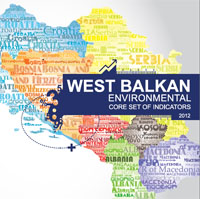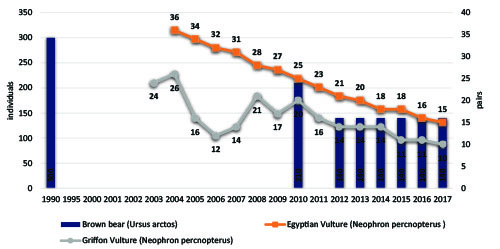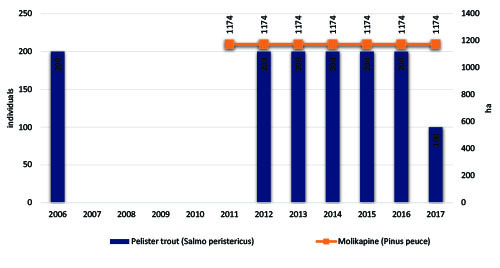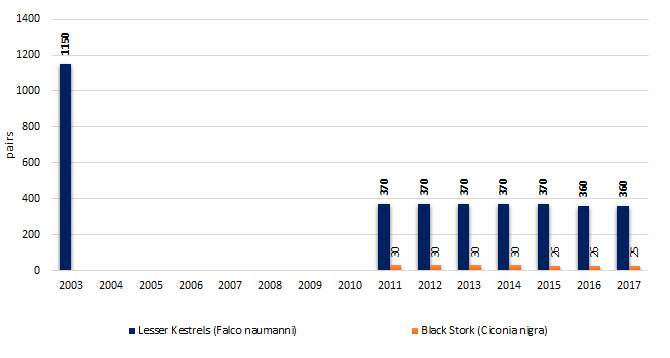| MK – NI 009
SPECIES DIVERSITY |
The indicator will show the trend in the number and distribution of selected species or species groups at national level, as relative assessment compared to the baseline year of the monitoring commencement.
Currently, groups of species that are taken into account are fish, birds and mammals from fauna, and higher plants of the flora.
The indicator shows the trend of several selected wild species: endemic fish (Pelister trout), predatory birds (eagles, vultures, falcons), water birds (black stork), then mammal-big beasts (brown bear) and conifers (Molikapine).
Number of species, estimated number of individuals for certain species, or diversity (ha).
What is the trend of the populations of selected plant species (Molikapine), fish, birds and mammals, what are the reasons that lead to a reduction in the number of them?
According to the available data, there is a decreasing trend in the number of populations in all observed species, except for the molybdenum, which in the considered period is spread to 1174 ha.
It is noted that with the ban on hunting and the implementation of several projects and programs focused on the protection of the brown bear, which belongs to group of Keystone species, in the period from 2012 to 2017, the number of population is stable.
Figure 1. Trend in number and distribution of Keystone species
Figure 2. Trend in number and distribution of Flagship species
Figure3. Trend in number and distribution of endemic species
Figure4. Trend in number and distribution of other species
Data coverage: excel
Source: Micevski, B. (1998): Ornithofauna of Lake Prespa, Vest. Micevski, B. (2000): Ornithofauna of tree natural lakes in Macedonia (Lake PRespa, Ohrid and Doiran), Final Report, FNSM. Micevski B.& Nastov.A. (2002): Conservationa of migratory birds in Macedonia, National Report to CMS and AEWA, UNEP, Bonn. Grubac, B. & Velevski, M. (2004 -2010): Survey and monitoring of the status, breeding success and threats to the Egyptian Vulture in Macedonia- Report to BVCF/FZS; 2. Grubac B., Velevski M., Lisicanec T., Lisicanec E., Rolevski, D.& Andevski, J. (2007): Decrease of population size of the Griffon vulture Gyps fulvus in Macedonia and assessment of conservation measures. III Congress of Ecologists of Republic of Macedonia, 06-09.10.2007, Struga. Abstract Book, 101-102. Macedonian Ecological Society; 3. Македонско еколошко друштво и Фонд за дивата флора и фауна. Velevski, M & all. (2012): State of Birds of Macedonia- Report of BL International and MES,MK, Velevski.M. & all.(2013): Vulture conservation in Macedonia, in Balkan Peninsula and Adjacent Region, Vulture Conservation Fondation and Frankfurt Zoological Society. MEPP&Scientific Project Team: Fift National Report for Biodiversity in Macedonia, UNEP/CBD, 2015. Nastov, A. & Micevski,B. (2017): Tematic Report of conservation status of selected migratory fauna species: birds and mammals in MK (UNEP/CMS). MEPP&Project Team (2017): Final Report of distribution of population and conservation status of key selected flora and fauna species , EU IPA Project for NATURA 2000 in Macedonia (2017). Nastov, A&Micevski, B (2018): National Riport for implementation of Ramsar Convention in MK.
The richness and heterogeneity of species and ecosystems are the basic features of biodiversity in the Republic of Macedonia. According to available information, this treasure includes an impressive figure of 17,604 species of which over 976 species are endemic. According to the analysis of the richness of the biodiversity of countries in the European continent, the Republic of Macedonia is at the very top of the list of countries known as “European Hotspot”.
The Ornithofauna of the Republic of Macedonia is represented by 338 taxa (309 species and 19 subspecies) of birds.
The European Red List includes 66 bird species that are found in Macedonia. Also, 115 Emerald species of birds have been identified (in accordance with Resolution No. 6 of the Berne Convention) that are present in Macedonia.
According to the available data in the category of Keystone species (Figure 1), the population of the eagle (Aquila heliaca) was monitored. It is noted that in the period from 2011 to 2017 the trend is negative so that the number of reproductive couples has dropped to 30 couples, which is a decline of 14.3%.
When monitoring the trend of number and distribution of Flagship species (Figure 2), one species of mammals (brown bear) and two species of predatory birds (white-headed and Egyptian vulture) were examined.
From the data it can be noticed that the number of Ursus arctos individuals decreased by 30% from 1990 to 2010, but in the period from 2012 to 2017 it is stable and amounts to 140 individuals.
For the white-headed vulture (Gyps fulvus) there is a trend of decreasing the number of populations, so in the period from 2003 to 2017 the number of reproductive couples decreased from 24 to 10 couples, which is a drop of 58.3%. Also, the number of Egyptian vulture population (Neophron percnopterus) decreased from 36 to 14 couples in the period from 2004 to 2017, a 61% drop.
When monitoring the trend of the number and distribution of endemic species (Figure 3), one plant and one animal species is considered. From the floral diversity as an endemic plant species, the fifth-pinus pine (Pinus peuce), which has been analyzed for 7 years (2011-2017), is singled out. Its status has not changed, more precisely it is spread to 1174 ha.
From the faunal diversity, the trend in the populations of a type of endemic freshwater fish Pelister trout (Salmo peristericus) was analyzed. For this species, there is a decrease in the number of populations in Brajcinska Reka (NP Pelister) from 200 to 100 reproductive indices, which is a decrease of 50%.
For the other species (Figure 4), on the basis of the available data, two species were examined: the Lesser Kestrels and the Black Stork.
In the Lesser Kestrels (Falco naumanni), the highest number of couples (1150) was recorded in 2003, after which there was a declining trend and in 2011 it amounted to 370 couples. This number of reproductive couples is constant by 2015, and then reduced in 2016 and 2017 to 360 couples.
For the Black Stork (Ciconia nigra), the number of couples shows a declining trend, with 30 reproductive couples in 2011 dropping to 25 couples in 2017 and a fall of 16.7%.
- Methodology for the indicator calculation
Sampling quadrants (10 – 15) with an area of 1 km2 are taken by random and common bird species were counted there by the method of linear transect. Counting took place in the period of nesting (from 15 April to 15 June) with the intensity of two searches per year. Data was statistically processed resulting in the established trend in the populations of species at national level.
With reference to birds of prey, full census of couples in nest and determination of their success in nest have been envisaged.
Source of used methodology
We applied methodology used by the organization British Trust for Ornithology in carrying out the census of birds in nests on the territory of the United Kingdom.
List of relevant policy documents
The Second National Environmental Action Plan, in its Chapter on Nature, emphasizes the goal of the establishment of integrated system for nature and biological diversity protection, in line with the EU standards and multilateral agreements. One of the actions envisaged for the goal achievement is development of national monitoring programme for biological diversity components and elaboration of national biodiversity indicators.
The National Strategy for Biological Diversity Protection with Action Plan defines integrated approach to the protection and sustainable use of components of biological diversity. The Action Plan outlines the specific actions to be taken to achieve the goals. The strategic commitment “Research and monitoring” includes action for national biodiversity indicators development. (D.1.11).
Legal grounds
The Law on Nature Protection provides for organization of monitoring of nature state. The monitoring methodology needs to be specified in a regulation. The monitoring over the state of nature is carried out through: measurement, observation, assessment and control of the state of species, their habitats, habitat types, environmentally important areas, ecosystems, landscape types, monitoring and assessment of geological values and monitoring of the state of natural heritage.
Identification of the trend in populations for selected bird species and establishment of the reasons leading to reduction in their number and development and implementation of measures for the negative trend halting (contribution to the achievement of the Target 2020 for biodiversity loss prevention/reduction by 2020).
UNEP/CBD Secretariat, UNEP/CMS Secretariat, AЕWA, EUROBATS, BC/CE Secretariat
| Code | Title of the indicator | Compliance with CSI ЕЕА or other indicators | Classification by DPSIR | Type | Linkage with area | Frequency of publication | |
| MKNI 009 | Species diversity | CSI 009 | Species diversity | S | Biological diversity | ||









































































